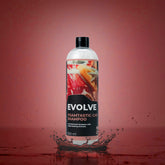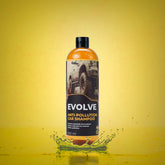How to Remove Scratches Safely from Car Paint at Home
by
Evolve Car Care
18 Sep 2025
Every car owner feels disappointed when they notice a scratch on their vehicle. Sometimes it is a thin line made by a key or a small branch, and sometimes it is a deeper mark caused by another vehicle brushing past.
Even small scratches can spoil the beauty of the car and make it look old. Taking the car to a workshop for scratch removal is always possible, but it can cost a lot of money and take several hours or even days.
The good news is that many scratches can be fixed at home with some patience, the right materials, and careful steps.
This blog explains how to remove different kinds of scratches from car paint at home. It also tells you about the layers of car paint, how to prepare the surface before starting, which products you should use, and when it is better to go to a professional.
By the end of this guide, you will feel more confident about repairing scratches on your own car.
Understanding Car Paint and Types of Scratches
Car paint is not just a single layer of colour. It is a system of several layers that work together to protect the car’s body and give it a shining look.
The topmost layer is the clear coat, which acts like a shield against sunlight, rain, and dust.
Under the clear coat lies the base coat, which is the coloured paint that makes the car look attractive.
Beneath the base coat is a layer of primer that helps the paint stick to the car and prevents rust.
The last layer is the metal body of the car itself.
Scratches can occur in any of these layers. If a scratch affects only the clear coat, it is known as a surface or light scratch. These are usually very thin and can be polished away quite easily.
When a scratch goes deeper into the base coat, it is called a medium scratch. These are more visible because the colour is damaged and may look dull compared to the rest of the paint.
The most serious type is a deep scratch, where the primer or even the bare metal is exposed. These scratches must be treated quickly, otherwise rust can start forming on the car’s body.
Preparing the Car Before Scratch Repair
Before you begin repairing scratches, you need to prepare the surface properly.
The first step is to wash the area around the scratch using car shampoo and water. This removes dirt and dust that could cause more scratches if rubbed during the repair process.
After washing, the area should be dried with a soft microfiber cloth to make sure there is no moisture left.
The next step is to carefully inspect the scratch in good lighting. One easy way to judge the depth is by running your fingernail over it.
If your nail does not get stuck, it means the scratch is shallow and only on the clear coat. If it gets caught, the scratch is deeper and may have reached the paint or primer.
Once you know the type of scratch, you can gather the materials required such as scratch remover, polishing compound, touch-up paint, primer, clear coat, fine sandpaper, masking tape, and clean microfiber cloths.
Preparation is very important because it prevents mistakes and ensures a better finish.
Repairing Clear Coat Scratches
Light scratches that affect only the clear coat are the easiest to repair at home. For this you can use a scratch remover or a polishing compound.
First, apply a small amount of the product on a clean microfiber cloth. Then rub it gently on the scratch in small circular motions.
It is important not to press too hard because the polish itself is designed to remove the scratch.
After rubbing for a few minutes, you will notice that the scratch begins to fade. Wipe away any extra product with a fresh cloth and check the surface in the light.
If the scratch has almost disappeared, you can finish by applying a thin layer of wax or sealant. This will restore the shine and protect the paint from future damage.
Repairing Base Coat Scratches
When scratches cut into the colour layer of the paint, they are more visible and require touch-up paint for repair.
Begin by cleaning and drying the area. Use masking tape around the scratch to protect the surrounding paint. Shake the bottle of touch-up paint well and apply it in thin layers using a fine brush or a paint pen.
It is better to apply two or three thin layers rather than one thick layer because thin layers dry faster and blend better. After each coat, wait for it to dry completely before adding the next one.
Once the touch-up paint has dried fully, you can use a small amount of polishing compound to smooth the edges and blend the repair with the rest of the car.
Finally, apply a clear coat to seal the colour and give it a natural shine. With careful work, the scratch will be much less visible and the paint will be protected from peeling or fading.
Repairing Deep Scratches
Deep scratches where the primer or metal is visible require more time and effort.
First, clean and mask the area to avoid spreading paint on nearby parts. Use very fine-grit sandpaper and wet it slightly with water. Gently sand the scratch to smooth the rough edges.
After sanding, let the area dry and apply a thin layer of primer. Allow the primer to dry completely before applying paint.
Next, apply base coat paint in thin layers just like you did for medium scratches. Be patient and give each layer enough time to dry.
Once the colour is applied, seal it with clear coat. After the final layer has dried completely, use polish to blend the surface and bring back the shine. Deep scratches take longer to repair and sometimes may still look slightly different from the original paint.
If the scratch covers a large area or is very deep, visiting a professional workshop may be the best option.
Things to Remember While Repairing Scratches
When repairing scratches, there are some important things to keep in mind.
- Always work on a clean surface, otherwise dirt may cause more scratches.
- Use only original or matching paint for your car, otherwise the repaired area will look patchy.
- Work slowly and give each layer enough drying time. Rushing will spoil the finish.
- After repairing, always apply wax or sealant to protect the paint from further damage.
There are also some things you must avoid.
- Do not use rough cloths or old rags because they can create new scratches.
- Do not apply too much pressure while polishing as it may damage the clear coat.
- Do not use household items like bleach, soda, or harsh toothpaste because these can harm the paint.
- And finally, do not attempt to repair very large or deep scratches if you are not confident. In such cases, it is safer to take the help of a professional.
Maintaining Your Car After Scratch Removal
Once the scratches are repaired, it is important to maintain your car so that new scratches do not appear quickly.
Wash your car regularly with car shampoo and always use microfiber cloths or mitts.
Wax your car every two to three months to create a protective barrier. If possible, apply ceramic coating as it gives longer protection.
Avoid parking under trees where falling branches or bird droppings can damage the paint. Try to park in shaded or covered areas to protect the car from sun and dust.
While washing, follow the two-bucket method to avoid swirl marks. If you are not using the car for a long time, keep it covered with a good quality car cover.
When to Visit a Professional
Not all scratches can be repaired at home. If the scratch is very deep and spreads across a large area, it is better to visit a professional body shop. If the scratch has already started rusting, professional treatment is necessary.
Some colours like metallic, pearl, or custom shades are very difficult to match with touch-up paint. In such cases, professionals use advanced machines and spray booths to give a perfect finish. If you are not confident or do not have the right tools, it is always safer to go to an expert.
Scratches on car paint are common, but they do not always mean an expensive repair. With the right steps and products, many scratches can be repaired at home. Light scratches on the clear coat can be polished away.
Medium scratches that reach the paint layer can be treated with touch-up paint and clear coat.
Deep scratches may require sanding, primer, and repainting. By being careful, patient, and systematic, you can restore your car’s shine and protect it from further damage.
However, remember that not every scratch can be handled at home. If the scratch is too big, too deep, or already rusted, a professional workshop is the best choice.
If you want professional-grade DIY products for your car care, you can explore Evolve Car Care products. Taking proper care of your car will keep it looking new for years.
FAQs
Can scratches disappear completely at home?
Yes, small, and medium scratches can often be repaired at home with polish and touch-up paint. Deep scratches may still need professional repair.
Is toothpaste safe for removing scratches?
Toothpaste may work on very light scratches, but it is not recommended for modern car paint. A proper scratch remover is always better.
How long does scratch repair take at home?
Light scratches may take less than an hour to repair. Deep scratches can take several hours or even a full day because each layer of paint and clear coat needs time to dry.
Can nail polish be used to cover scratches?
Nail polish is not suitable for car paint. It may look fine for a short time but will peel off quickly. Always use proper touch-up paint that matches your car colour.
How can scratches be prevented in the future?
Regular washing, waxing, careful parking, and using a good car cover can help in preventing scratches.
Tags:




